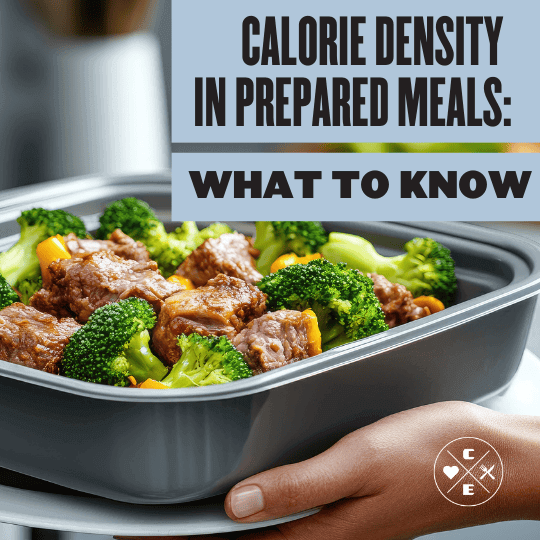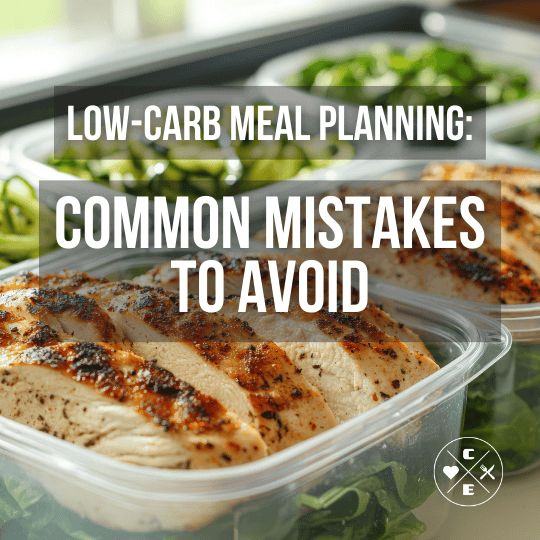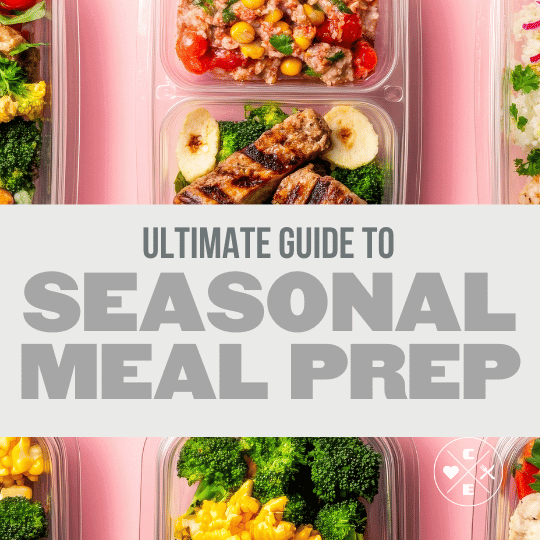
Calorie Density in Prepared Meals: What to Know
Jason Nista
Nutrition
7 minute read
Table of Contents
Want to manage your portions and calories without the hassle? Here's what you need to know about calorie density and how prepared meals can help:
- What is calorie density? It's the number of calories in a given weight of food. Low-calorie-density foods (like vegetables) help you feel full with fewer calories, while high-calorie-density foods (like fried items) pack more calories into smaller portions.
- Why does it matter? Understanding calorie density helps you make smarter meal choices, control portions, and achieve your health or weight goals.
- Prepared meals like Clean Eatz Kitchen simplify this process with portion-controlled options that focus on balanced nutrition, lean proteins, fiber-rich vegetables, and healthy cooking methods.
Key Takeaways:
- Aim for meals under 600 calories with lean proteins, non-starchy vegetables, and whole grains.
- Cooking methods like grilling or steaming keep calorie density low, while frying increases it.
- Prepared meal services offer convenience, consistent calorie counts, and variety through rotating menus.
Pro Tip: Save money by ordering in bulk and pair these meals with fresh fruits or veggies to meet your dietary needs.
Want more details? Keep reading for tips, meal examples, and how Clean Eatz Kitchen aligns with these principles.
What 600 Calories Look Like With Different Foods
Understanding Meal Calorie Density
Calorie density in meals depends on portion size and ingredients. A well-balanced meal combines foods with varying calorie densities to hit nutritional targets. This concept is central to the portion-controlled meals offered by Clean Eatz Kitchen.
Factors That Influence Calorie Density
Proteins have a major effect on calorie density. For instance, lean proteins like chicken breast (165 calories per 6 oz) provide nutrients with moderate calories. On the other hand, ribeye steak (330 calories per 6 oz) is much higher in calories.
Vegetables are key to managing calorie density. Non-starchy vegetables like broccoli, cauliflower, and leafy greens contain just 25–50 calories per cup but add plenty of volume to your plate.
Smart Portion Guidelines
- Protein: Stick to 4–6 oz, about the size of a deck of cards.
- Vegetables: Fill half your plate with non-starchy options.
- Complex Carbohydrates: Use ½–1 cup of whole grains like brown rice or quinoa.
Example of a Balanced Meal
A well-balanced meal might include:
- 5 oz of lean protein (140 calories)
- 2 cups of mixed vegetables (50–75 calories)
- ¾ cup of whole grains (150 calories)
This meal would total around 350–400 calories, with a calorie density of about 1.2 calories per gram. The water and fiber in vegetables help you feel full without adding extra calories.
Cooking Methods and Their Impact
How you prepare food can change its calorie density significantly. Methods like steaming, grilling, or baking add minimal calories. In contrast, frying can double or even triple the calorie count. For example, a 6 oz grilled chicken breast has 165 calories, but the same portion fried could reach 350 calories.
1. Clean Eatz Kitchen Features
Clean Eatz Kitchen puts the principles of calorie density and balanced meal composition into action. Their meals are designed to support healthy eating habits without the hassle of constant calorie tracking. Here's how these ideas come to life in their meal offerings.
Portion Control and Calorie Management
The Weight Loss Meal Plan focuses on keeping meals under 600 calories. This is achieved by:
- Using low-calorie, high-volume vegetables
- Carefully portioning complex carbohydrates
- Employing cooking methods that avoid unnecessary calories
Meal Plan Options
Clean Eatz Kitchen provides a variety of meal plans tailored to different nutritional goals:
| Meal Plan Type | Features |
|---|---|
| Weight Loss | Meals under 600 calories with balanced macros |
| High Protein | Protein-rich meals with balanced macros |
| Build Your Meal Plan | Fully customizable options from a rotating menu |
| Hall of Fame | Customer favorites with balanced nutrition |
These plans highlight their focus on well-portioned, nutrient-packed meals.
Nutritional Balance
A rotating menu ensures variety while sticking to the principles of calorie density. Each meal includes:
- Lean protein sources
- Measured servings of whole-grain carbohydrates
- A generous portion of nutrient-dense vegetables
- A healthy balance of proteins, carbs, and fats
Convenience Features
- Meals are frozen to lock in freshness
- Ready to heat in the microwave within minutes
- No subscription required
- Nationwide delivery available
- Bulk purchasing options for added savings
These features make it simple for anyone to enjoy meals that align with their health goals while staying mindful of calorie intake.
sbb-itb-1989a25
2. Industry Standards
The prepared meal industry has shifted focus to portion sizes and meal customization, helping consumers make better choices about calories and nutrition. These practices form the backbone of industry standards.
Portion Control Standards
Portion control plays a key role. By offering balanced servings, meal services make it easier to manage calorie intake and ensure consistent nutrition across different meal options.
Customization Options
Many meal services let customers tailor their meals to fit specific needs, such as high-protein, low-carb, or gluten-free options. This approach helps people stick to their calorie goals and meet dietary preferences.
Menu Rotation
Rotating menus each month introduces variety and uses seasonal ingredients. This keeps customers interested while still maintaining consistent calorie and nutrition standards.
Benefits and Limitations
Knowing the pros and cons of prepared meals can help you decide if they fit into your lifestyle. Here's a breakdown of the key aspects of calorie-controlled prepared meals:
| Aspect | Benefits | Limitations |
|---|---|---|
| Calorie Control | • Exact portion sizes • Pre-measured ingredients • Consistent calorie counts | • May not meet all energy needs • Limited ability to adjust portions |
| Nutritional Balance | • Balanced nutrients • Expertly planned meals • Controlled sodium levels | • Fixed nutrient ratios • May not align with specific dietary plans |
| Convenience | • No meal prep needed • Ready in minutes • Less food waste | • Requires storage space • Needs freezer capacity • Fixed meal times |
| Cost Effectiveness | • Savings with bulk orders • No wasted ingredients • Predictable food costs | • Higher cost per meal than cooking at home • Minimum order requirements |
You can make the most of these meals by following some practical tips.
Maximizing Benefits
Here are some ways to get the most out of calorie-controlled meals while minimizing their downsides:
- Storage Tips: Keep meals at 0°F (-18°C) for up to six months to maintain quality.
- Meal Integration: Combine prepared meals with other flexible eating habits. For example, Clean Eatz Kitchen’s Weight Loss Meal Plan offers balanced options under 600 calories.
- Save Money: Order in bulk to cut costs. Clean Eatz Kitchen’s Bulk Boxes provide 30 meals for $205.00, averaging about $6.83 per meal.
Addressing Limitations
Understanding the limitations can help you adapt these meals to your needs.
- Portion Adjustments: While portions are fixed, you can add snacks or sides to meet your needs. Clean Eatz Kitchen offers protein-packed snacks like empanadas for $4.79.
- Diet Customization: Opt for build-your-own meal plans to personalize meals while keeping calorie counts in check.
- Storage Solutions: Organize your freezer by meal type, use a first-in, first-out system, and consider a secondary freezer for larger orders.
These strategies can help you enjoy the convenience of prepared meals without compromising on your dietary goals.
Summary and Recommendations
Understanding calorie density can help you make better choices when it comes to prepared meals. Here’s how you can align your meal selections with your personal goals:
For Weight Management
Opt for meals under 600 calories that include lean proteins and plenty of fiber-rich vegetables. Clean Eatz Kitchen’s Weight Loss Meal Plan offers portion-controlled options designed to support weight loss.For Active Lifestyles
Choose meals high in protein to aid muscle recovery and maintain energy. The High Protein Meal Plan delivers a good balance of macronutrients tailored to fitness goals. Look for meals with balanced carbs to keep your energy steady.For Budget-Conscious Planning
Save money by ordering in bulk. Clean Eatz Kitchen’s Bulk Boxes allow you to reduce the cost per meal through volume discounts.
Smart Selection Tips
- Check nutritional labels to ensure meals match your dietary needs.
- Explore customizable meal plans to accommodate specific preferences or restrictions.
- Pair prepared meals with fresh fruits and vegetables for added nutrients.
- Keep an eye on portion sizes and calorie counts to maintain a balanced intake.
Choosing the right prepared meals can help you stick to a healthy diet while saving time.
Related Articles
Low-Carb Meal Planning: Common Mistakes to Avoid
8 minute read
Ultimate Guide to Seasonal Meal Prep
9 minute read
Ultimate Guide to Seasonal Meal Prep
9 minute read


